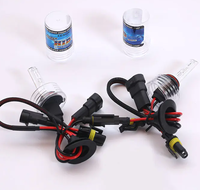The Principle Of Hid Car Xenon Lights
-
If you've been thinking about upgrading your car light bulbs, you've definitely come across the terms "xenon" and "HID." A popular feature on many modern vehicles, HID car xenon lights are a great way to add a stylish touch.
Xenon headlights have been around since the early 1990s and have grown in popularity since then. You'll be able to spot these headlights easily on the road thanks to their icy white/blue hue and extreme brightness. But how exactly do these headlights work?
Xenon HID (High-Intensity Discharge) bulbs are filled with xenon gas and contain two electrodes - one at each end of the tubular bulb. When the bulb is turned on, an electric current is passed between the two electrodes, and the xenon gas lights up. Xenon is actually only used during bulb activation. Once the desired temperature inside the lamp is reached, other gases inside the bulb ensure it stays lit.
Xenon headlights are a set of lighting arrays that use xenon bulbs instead of traditional halogen bulbs. As we have learned, xenon headlights contain xenon particles that wait to discharge to illuminate and emit blue light. Xenon bulbs are much more expensive and are usually optional (cost) extra or only with famous brands like Mercedes, BMW, Porsche, and Land Rover.
Visually, xenon headlights look more or less the same as halogen or LED lights. At night, vehicles with xenon headlights really stand out because they have a very distinct bright blue/white light that can emit up to three times as brightly, which is a godsend for drivers, but for pedestrians and other drivers, this may not be a gift.
Typically, cars with xenon headlights will still have a halogen bulb for the high beam, but there are also some that are entirely xenon, called bi-xenon headlights.
Haining Suez Car Lights Co., Ltd. is a LED car headlights supplier, the main products are H7 car bulbs, etc. Welcome to consult!
